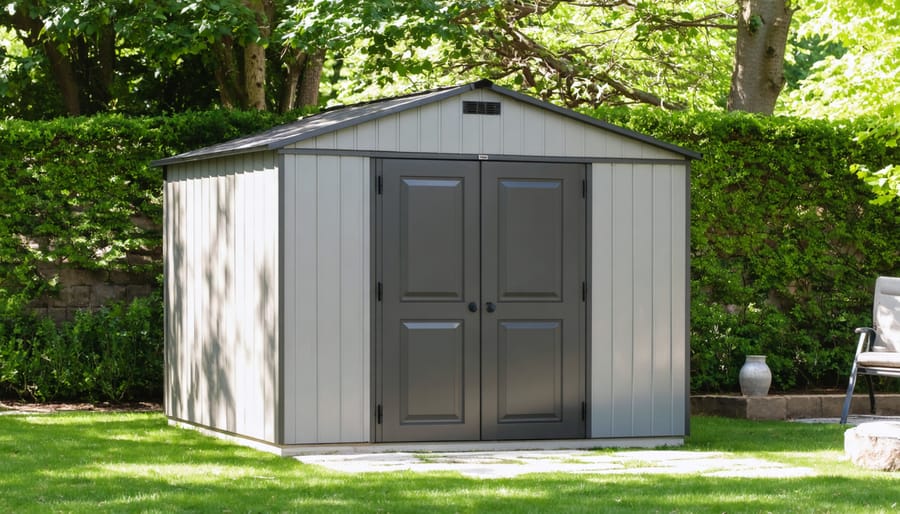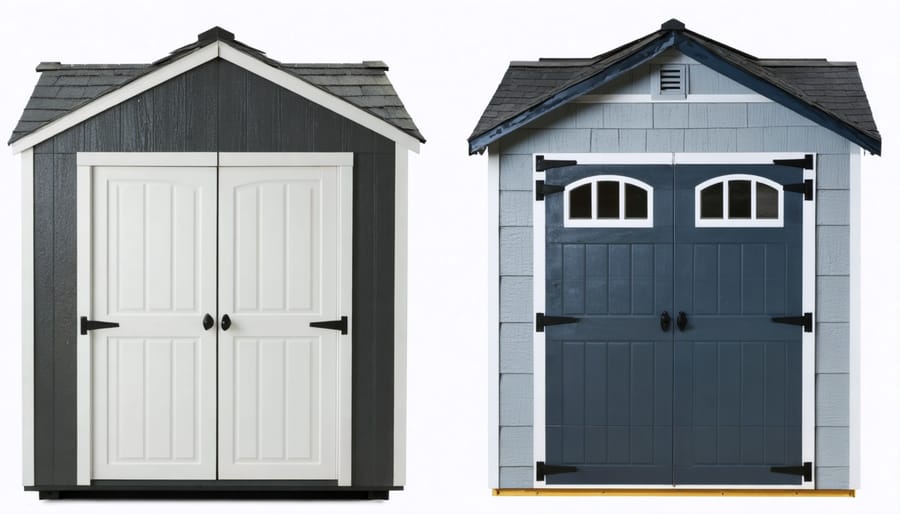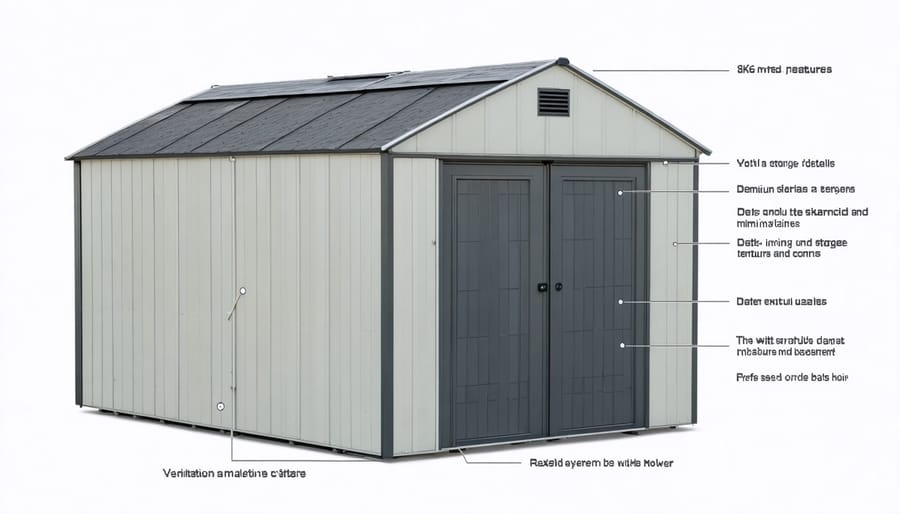What Makes a Storage Shed Worth Every Penny (Quality Features That Matter)

A quality storage shed stands as a critical investment in protecting valuable belongings while enhancing your property’s functionality and value. Choosing a quality storage shed demands attention to key characteristics that distinguish exceptional builds from mediocre alternatives. Premium sheds feature weather-resistant materials like pressure-treated lumber or heavy-gauge steel, reinforced flooring systems that prevent moisture damage, and strategic ventilation design to regulate internal temperature and humidity. Superior construction details, including robust door frames, premium hardware, and precise assembly techniques, ensure decades of reliable service while maintaining structural integrity through various weather conditions. Beyond mere storage space, a high-quality shed represents a long-term solution that combines durability, functionality, and aesthetic appeal to meet diverse storage needs while protecting your investment.
Essential Construction Materials That Define Quality
Weather-Resistant Materials
A quality storage shed starts with weather-resistant materials that can withstand nature’s challenges year after year. High-grade vinyl and treated wood are popular choices, offering excellent protection against rain, snow, and UV rays. Vinyl sheds are particularly impressive, requiring minimal maintenance while resisting rust, rot, and fading.
For metal sheds, look for galvanized steel with protective coatings that prevent corrosion. These materials often come with warranties of 15 years or more, demonstrating their durability. Quality resin panels are another excellent option, featuring UV inhibitors that prevent sun damage and maintain their appearance over time.
The roof materials deserve special attention, as they take the brunt of weather exposure. Premium sheds use heavy-duty shingles or metal roofing with proper underlayment to prevent leaks. Some manufacturers incorporate special water-channeling designs and reinforced seams to direct moisture away from the structure.
Remember that superior weather resistance isn’t just about the materials themselves – it’s about how they’re assembled. Quality sheds feature overlapping panels, weather stripping, and properly sealed joints to create a truly weather-tight structure.

Structural Components
A quality storage shed starts with robust structural components that ensure stability and longevity. The frame serves as the skeleton of your shed, typically constructed from pressure-treated lumber or galvanized steel to resist rot and rust. Look for sheds with 16-inch center spacing between wall studs and roof trusses, which provides optimal support and durability.
The foundation is crucial for your shed’s long-term performance. A level, well-draining base made from concrete, gravel, or specially designed shed pads prevents moisture damage and keeps your structure stable. For wooden sheds, floor joists should be pressure-treated and elevated slightly off the ground to promote airflow and prevent rot.
Support beams and cross-bracing add essential stability to your shed’s structure. Quality sheds feature reinforced corners and properly sized headers above doors and windows to distribute weight evenly. The roof system should include sturdy rafters or trusses that can handle local snow loads and severe weather conditions.
Remember, while these components might not be immediately visible, they’re vital investments in your shed’s durability and safety. A properly built structure will protect your belongings and maintain its value for years to come.

Design Features of Premium Storage Sheds
Ventilation and Moisture Control
Effective ventilation and moisture control are crucial elements that distinguish a quality storage shed from a subpar one. Proper ventilation systems help maintain a healthy environment inside your shed, protecting your valuable belongings from moisture damage, mold growth, and rust.
A well-designed shed should feature strategically placed vents, typically including soffit vents near the roof line and gable vents on the end walls. This combination creates natural airflow, allowing warm, humid air to escape while fresh air enters from below. Look for sheds with built-in ridge vents or turbine vents on the roof for enhanced air circulation.
Moisture control extends beyond ventilation. Quality sheds incorporate vapor barriers in the walls and floor, preventing ground moisture from seeping upward. The foundation should be elevated slightly off the ground, and the roof should have adequate overhang to direct rainwater away from the walls.
Consider installing a small dehumidifier or moisture-absorbing products in regions with high humidity levels. Smart design features like weatherstripping around doors and windows, along with properly sealed joints and seams, provide additional protection against moisture intrusion.
Remember, good airflow not only protects your stored items but also extends the life of the shed itself by preventing wood rot and structural deterioration.
Security and Access Features
A quality storage shed’s security features start with a well-built door that operates smoothly and closes firmly. Look for doors with heavy-duty hinges that won’t sag over time and weather-resistant seals to prevent water infiltration. Many premium sheds come with double doors, making it easier to move large equipment in and out while providing extra stability when locked.
Speaking of locks, invest in a high-quality padlock or keyed entry system. The best sheds feature reinforced hasp and staple locks or sophisticated deadbolt systems. Some modern options even include smart locks that you can control from your phone, adding an extra layer of convenience and security.
Windows, while great for natural light, should be positioned strategically and include security features like wire mesh or reinforced glass. Consider installing motion-sensor lights around your shed to deter potential intruders and make nighttime access safer.
Don’t overlook the importance of a raised foundation – it not only protects against moisture but also makes it harder for pests to access your stored items. Some quality sheds feature built-in floor joists that create a barrier against unwanted visitors.
For added security, consider installing an alarm system or security cameras. Many homeowners find peace of mind by connecting their shed’s security features to their home’s existing security system, creating a comprehensive protection plan for all their valuable belongings.
Long-Term Value Indicators
Warranty Coverage
A quality storage shed’s warranty coverage speaks volumes about its durability and the manufacturer’s confidence in their product. Most reputable manufacturers offer warranties ranging from 10 to 30 years, with premium sheds often featuring lifetime coverage against defects in materials and workmanship.
Pay close attention to what the warranty actually covers. A comprehensive warranty should protect against material defects, structural issues, and weather-related damage. Look for coverage that includes the roof, walls, floor system, and door hardware. Some manufacturers even offer separate warranties for different components, with longer coverage periods for structural elements.
The best warranties are transferable to new owners and don’t require complicated registration processes. Be wary of warranties that include numerous exclusions or require professional installation to remain valid. A quality manufacturer will clearly state their warranty terms and provide straightforward claim procedures.
Remember that a longer warranty period often indicates higher-quality materials and construction methods. However, always read the fine print and understand the maintenance requirements to keep your warranty valid. Regular upkeep, such as cleaning and proper drainage maintenance, is typically required to maintain warranty coverage.
Maintenance Requirements
Regular maintenance is key to preserving your storage shed’s quality and extending its lifespan. A well-maintained shed not only looks better but also provides reliable protection for your belongings year after year. Start with seasonal inspections of your shed’s exterior, checking for any signs of wear, damage, or potential water entry points. Clean gutters and downspouts regularly to prevent water damage, and ensure proper drainage around the foundation.
For optimal long-term shed maintenance, keep the interior organized and well-ventilated to prevent moisture buildup. Lubricate door hinges and handles annually, and check weather stripping around windows and doors to maintain a weathertight seal. Touch up paint or stain as needed to protect exterior surfaces, typically every 2-3 years depending on climate exposure.
Pay special attention to the roof, checking for loose shingles or damage after severe weather events. Keep trees and bushes trimmed away from your shed to prevent debris accumulation and potential structural damage. For metal sheds, inspect regularly for rust spots and address them promptly with appropriate rust-resistant primers and paints. Remember that addressing small maintenance issues quickly can prevent costly repairs down the road and ensure your storage shed remains a valuable addition to your property.
Installation and Assembly Quality
A quality storage shed starts with proper installation and assembly, which directly impacts its longevity and performance. Whether you’re working with professionals or tackling the project yourself, establishing a solid foundation is crucial. Start by ensuring your site is level and well-drained, using concrete blocks, gravel, or a concrete pad as your base. Even a slight tilt can lead to door alignment issues and structural stress over time.
When assembling your shed, follow the manufacturer’s instructions carefully, and don’t rush the process. Pay special attention to sealing joints and connections, particularly around windows and doors, as these are common areas for water infiltration. Using quality hardware and ensuring proper alignment of all components will prevent future issues like sagging doors or leaky roofs.
Weather conditions during installation matter too. Avoid assembling your shed on extremely hot days when materials might expand, or during wet weather that could compromise sealing compounds. Having an extra pair of hands during installation can make a significant difference in accuracy and safety.
For larger sheds or complex designs, consider professional installation services. The additional cost often pays for itself through proper assembly and reduced maintenance needs. Remember, even the highest-quality shed materials can underperform if not installed correctly, making proper installation just as important as the quality of the materials themselves.

Choosing a quality storage shed is an investment in your property’s functionality and value. By focusing on durable materials like treated wood or heavy-gauge steel, weather-resistant features, and proper construction techniques, you’ll ensure your shed stands the test of time. Remember to consider your specific storage needs, available space, and local climate when making your selection. A well-built shed should offer ample ventilation, a sturdy foundation, and security features to protect your belongings. Don’t forget to check local building codes and obtain necessary permits before installation. While premium materials and construction may cost more initially, they typically deliver better long-term value through durability and reduced maintenance needs. By carefully evaluating these factors and choosing a reputable manufacturer or builder, you’ll end up with a storage solution that serves your needs for years to come.

